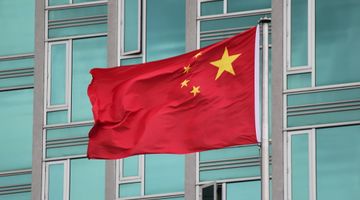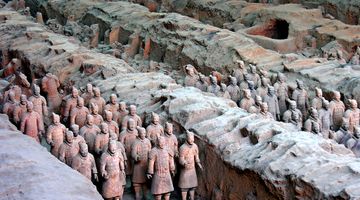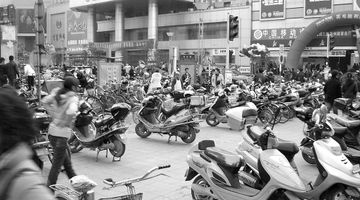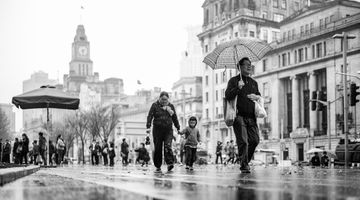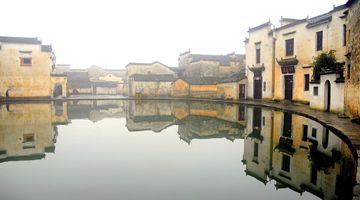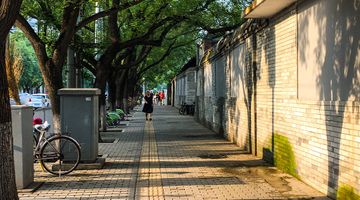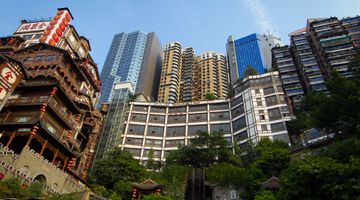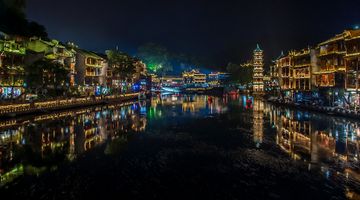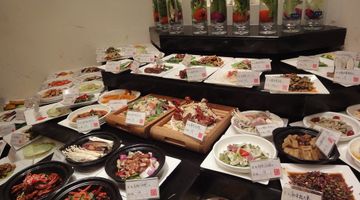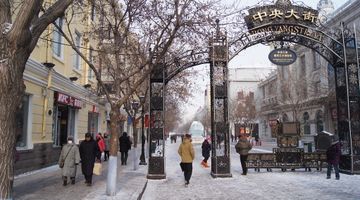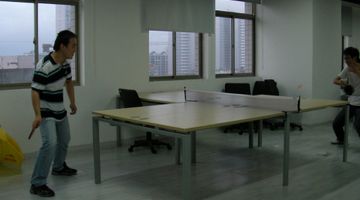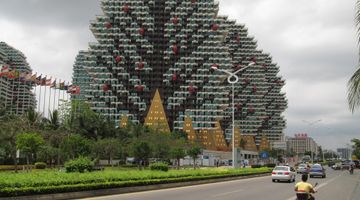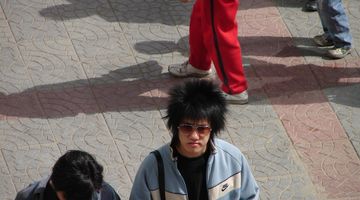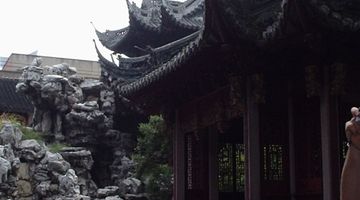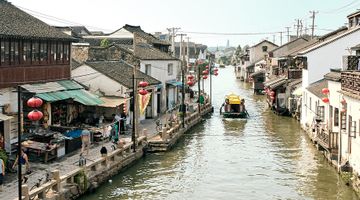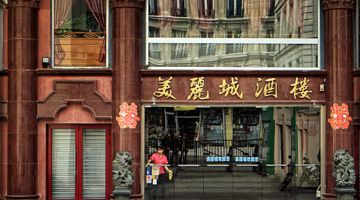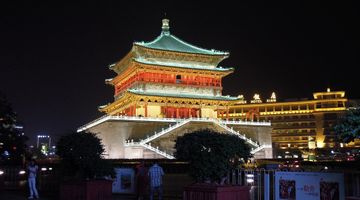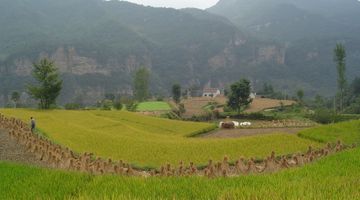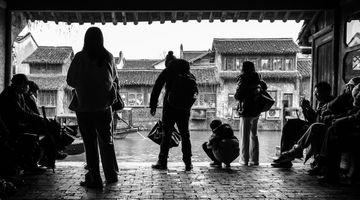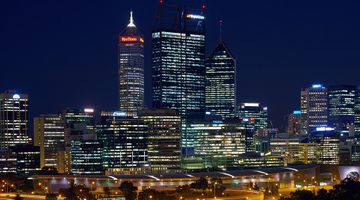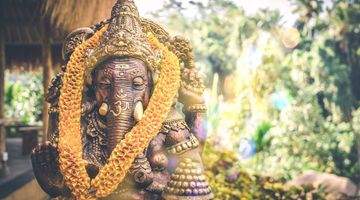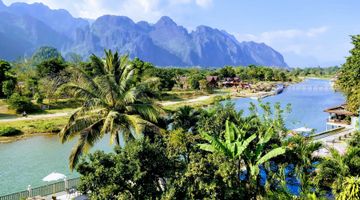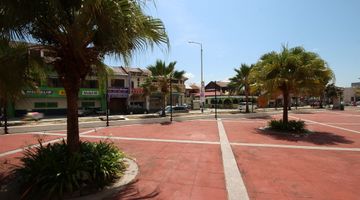12Go China Travel Guide. Why Go and What to See in 2026
China is a country that’s as mysterious as it is beautiful. Most people think of the Great Wall and terracotta warriors, but it’s so much deeper than that. Chinese people are immensely proud of their 5000-year-old culture, and this is evidently seen through the celebrations of a history that forms part of the four great ancient civilizations.
Obviously, their cultural roots are deep, so there’s an abundance of things to do and see if you’re into culture and heritage. However, China is also a country endowed with magnificent natural landscapes, from massive green mountains reaching into the clouds to tropical island paradises.
Although some may be hesitant to explore this dauntingly huge place, the rewards for the brave are infinite.
Why should you visit China?
1. China is beautiful
It’s a big country, so the diversity of natural landscapes will blow your mind! Down south, you’ll find big tropical islands that compare with the best in Asia.
The tropical island of Hainan has picture-book white sand beaches, leaning coconut trees, and sky-blue waters. In the north west, you’ll find barren desert landscapes around Xinjiang.
Move east from there and you’ll find the cold but magnificent ice city of Harbin. The reaching mountain peaks and peaceful waters of Hangzhou’s West Lake will leave you with memories (and photos) that you’ll treasure for a lifetime.
It’s not all nature, too; the dazzling scenes from Shanghai’s Bund promenade will make you believe you’ve moved 100 years into the future.
2. China is convenient
With thousands of international flights landing and taking off from Shanghai, Hong Kong, and Beijing, it comes as no surprise that it’s a walk in the park to get in and out of China. Their extensive flight networks will whisk you away to all parts of the country cheaply and safely.
Take one of their high-speed trains if you’d like to explore the country at eye level, watching the green countryside go by as you thunder through at breakneck speeds.
Not only cheaper than flying, they’re also super-fast! Most decent hotels will have English-speaking staff, and things like food, transport, and sightseeing are generally quite cheap. It’s developed into a very modern place, so the infrastructure is top-class.
3. China is different
You’ve been to the beach before. You’ve ridden a rollercoaster at Disneyland. You’ve made friends with another American couple at your luxury Western hotel.
Give China a try, because it’s something like you’ve never experienced before.
It’s about as far from the Western way of life as you can get, so venture out and get uncomfortable! Locals probably won’t speak your language, the food won’t be all burgers and fries, and you’ll do things you could only do in China. If you want a unique experience unlike any other, then China’s your place!
4. China has food that’s to die for
The menu at your local Chinese take-out is a poor representation of Chinese cuisine, to say the least.
China has a remarkably diverse food scene, and you’ve just got to be there to understand what we mean.
From the confusingly spicy, numbing sensation of the Sichuan pepper to the crispy Beijing roast duck, it offers up a feast for the taste buds.
Their emphasis is on fresh, local ingredients prepared the same way they’ve been done for centuries.
5. Impressive culture
It’s one of the biggest motivations for people wanting to visit the Middle Kingdom, and for good reason.
Its extensive history has left behind fascinating relics of a bygone era that are still as important to the locals now. The tourist attractions are very well maintained.
Go see one of their many majestic temples for a culturally enriching experience that will take you back all the way to the Xia dynasty thousands of years ago.
What is the best time to visit China?
The best time to visit China depends on the regions you plan to see, as the climate varies widely.
Spring (March–May) offers pleasant temperatures and blooming flowers, ideal for Beijing, Xi’an, and scenic areas like Guilin. Rain can be unpredictable in the south.
Autumn (September–November) has mild temperatures, clear skies, and beautiful fall foliage, often considered the best overall season.
Summer(June–August) is hot and humid, with crowded tourist spots, but mountain areas like Tibet and Yunnan are lush and accessible.
Winter (December–February) is very cold in the north but mild in the south, with fewer tourists at major attractions. Harbin is famous for its ice festival, best visited in winter.
How to get to China?
The easiest way to get to China is usually by plane. Major airports are Beijing, Shanghai, Guangzhou, and Chengdu. Most international flights connect from Europe, North America, or Asia.
You can also enter by train from Vietnam, Kazakhstan, Mongolia, or Russia — it is slower, but scenic. Border crossings by car or bus exist with Vietnam, Laos, Myanmar, and Nepal, though visas and planning are needed.
Ferries from South Korea or Japan are rare, mostly for cargo or short trips. Flights are the fastest and simplest option. Trains and land routes are more adventurous but take longer. Choosing the route depends on where you’re starting from.
How to travel to China from Europe?
The easiest and cheapest way from Europe to China is usually by air, with direct flights from hubs like Istanbul, Warsaw, Budapest, or Prague to Beijing, Shanghai, or Guangzhou taking 8–12 hours.
How to travel from Asian countries to China?
Getting to China from other parts of Asia is straightforward. By air is the fastest, with direct flights from major hubs like Bangkok, Singapore, Tokyo, Seoul, or Delhi to Chinese cities such as Beijing, Shanghai, or Guangzhou.
Overland travel is also possible from neighboring countries: you can take trains or buses from Vietnam, Laos, Myanmar, or Kazakhstan.
Sea routes exist from ports like Singapore or Thailand, but they are slower and less common.
How to get to China from Australia?
The fastest way from Australia to China is by air, with direct flights from Sydney, Melbourne, Brisbane, or Perth to Beijing, Shanghai, or Guangzhou, usually taking 9–11 hours.
How to get from the United States to China?
The quickest way from the U.S. to China is by air, with direct flights from major hubs like Los Angeles, San Francisco, New York, or Chicago to Beijing, Shanghai, or Guangzhou, typically taking 12–14 hours.
Transportation in China
So, how to get around China? China’s transport system is a sprawling, high-tech network that reflects the country’s scale and ambition. Its high-speed rail network, among the largest in the world, connects major cities like Beijing, Shanghai, and Guangzhou at speeds of up to 350 km/h, while conventional trains and urban metros link smaller cities and support daily commutes.
Roads are equally extensive, with expressways connecting provinces, national highways threading through towns and rural areas, and urban streets served by buses, taxis, ride-hailing apps, and a growing number of electric scooters and shared bikes.
Air travel is booming, with hubs such as Beijing Capital and Shanghai Pudong handling both domestic and international flights. Waterways, including the Yangtze and Pearl Rivers, carry freight and passengers, and ports manage some of the world’s busiest shipping traffic.
Traveling across China requires careful planning due to its vast size. For long distances, flying is the quickest option, though Chinese airline websites often accept only local payment methods—booking through 12Go makes the process simple and hassle-free. Trains are ideal for seeing the country and meeting locals, offering options from hard seats to soft sleeper cabins; high-speed trains are quicker but more expensive.
Taxis and ride-hailing services are cheap and convenient, while scooters, bicycles, and e-bikes are practical for short trips. Planning ahead is essential, as tickets for trains and buses can sell out quickly. By combining planes, trains, buses, and local transport, traveling smoothly across China is entirely possible.
Popular Travel Routes in China
• Beijing to Shanghai: Fastest and busiest high-speed rail route, connecting political and financial capitals.
• Shanghai to Hangzhou: Short, scenic route, popular for weekend trips.
• Beijing to Xi'an: Historic journey connecting the capital with the Terracotta Army and ancient Silk Road sites.
• Guangzhou to Shenzhen - Hong Kong: Key southern corridor linking major economic hubs.
Where to travel in China?
China is a huge country, so deciding where to go can be quite daunting. That’s why we’re here to help! China offers something for everyone, with its rich cultural heritage, scenic surroundings, and trendy food scene.
When you think about China, there are, of course, some things that will instantly pop into your head: mountains, temples, and so on.
So, if you’re visiting there with a specific interest in the following sights and activities, this is where you need to go:
Beijing
There’s a saying in China that states if you’ve never been to the Great Wall, you are not a true man. The wall is generally what most people instantly associate the country with, and a visit to the Great Wall will reward you with breath-taking scenery, oodles of culture, and some great exercise!
Wall aside, you can also go see the early morning flag-raising at Tiananmen Square, and the city has hundreds of temples to see, too-check out the Forbidden City.
Beijing is also a city full of energy, and it’s truly a melting pot of both Chinese and foreign cultures- this is apparent through its diverse food scene and nightlife, as well as the super-luxurious hotels and shopping malls.
There’s also a very solid food scene, world-class spas, and lots of cultural attractions, too. Like that aside, the shopping is awesome!
Where to travel from Beijing?
1. Beijing to Shanghai
Beijing–Shanghai travel takes 4–6 hours on high-speed trains or about 1.5-2 hours by plane. Flights are fastest but pricey (USD 289–643), while trains are cheaper (USD 30–160) with 12 daily departures.
2. Beijing to Xian
You can travel from Beijing to Xian by plane or train, with flights taking around 3 hours and trains from 5 up to 21 hours. Ticket prices vary widely: flights cost USD 70–810, while trains range from USD 80–275, with about 40 flights and 50 trains daily.
3. Beijing to Shenzhen
You can travel from Beijing to Shenzhen by plane or high-speed train. Flights take about 3 hours and start around USD 50, while high-speed trains take roughly 8 hours with prices from USD 45.
4. Beijing to Harbin
To travel from Beijing to Harbin, you can take a flight or a train, with flights being the fastest (around 2 hours) and trains slower but more affordable (as low as $30, up to $132). The distance between the two cities is 969 miles (1,559 km), and there are 37 trains per day. Flights are convenient for speed, while trains are popular for comfort and cost, with most travelers preferring second-class seats.
Shanghai
Shanghai offers a mix of city life, culture, and quiet escapes. Start with Nanjing East Road and The Bund, where historic buildings meet the river. Wander through Yuyuan Garden and Shanghai Old Street to see traditional architecture and local life.
Visit Jing’an Temple: a historic Buddhist temple in central Shanghai, known for its peaceful courtyards, bronze Buddha statues, and traditional architecture—a calm pause amid the city.
Take a morning trip to Zhujiajiao Water Town to walk along canals and cross stone bridges, surrounded by old houses and a sense of calm. In the afternoon, explore the French Concession, Tianzifang, and Xintiandi, where narrow streets, old houses, and small shops tell stories of the city’s past.
For a day trip, go to Hangzhou and start at West Lake, a UNESCO World Heritage Site known for its scenery. Visit the China National Tea Museum and Longjing Tea Village to learn about green tea traditions.
Back in the city, Qinghefang Ancient Street offers a glimpse of old shops and local crafts, and the Museum of Chinese Medicine shows another side of China’s history and culture.
Where to travel from Shanghai?
1. Shanghai to Shenzhen
You can travel from Shanghai to Shenzhen by plane (3 hours) or train (10–23 hours), depending on whether you prioritize speed or cost. Flights cost $103–$898, while train tickets range from $136–$413, with second-class trains offering a comfortable option.
2. Shanghai to Yunnan
Travel from Shanghai to Yunnan is possible by plane or train, with flights taking around 2 h 50 m and trains taking longer but costing as little as $49. Flights are the fastest option, while trains are the most popular and budget-friendly choice.
Xian
Xi’an, once the eastern terminus of the Silk Road and the capital of 13 dynasties, brims with history at every turn. The Terracotta Army, thousands of life-sized clay soldiers guarding Emperor Qin Shi Huang’s tomb, remains the city’s most arresting sight.
At the Shaanxi History Museum, artifacts from the Qin and Han dynasties offer a window into China’s ancient civilisation.
The Daci’en Temple, home to the Giant Wild Goose Pagoda, invites quiet reflection alongside sweeping city views.
Cyclists and walkers alike can trace the Ancient City Wall, one of China’s best-preserved fortifications.
The Bell and Drum Towers, icons of Xi’an, dazzle with evening illuminations.
The Muslim Quarter in Xian pulses with life, aromas, and the fusion of cultures, while the Great Mosque reflects an intriguing blend of Islamic and Chinese architecture.
Datang Everbright City juxtaposes history with modernity through shopping and entertainment. For a slower pace, the Daming Palace National Heritage Park offers greenery and remnants of imperial grandeur.
Where to travel from Xian?
Xi’an to Beijing: High-speed trains take 4.5–6 hours; daily buses are also available. Starting price: ~$31 https://12go.asia/en/train/xian/beijing
Xi’an to Chengdu: High-speed trains take ~3 hours; flights are also offered. Starting price: ~$27 https://12go.asia/en/travel/xian/chengdu
Xi’an to Shanghai: Train journeys vary from 13–50 hours, or take a flight starting from 51 USD. https://12go.asia/en/travel/xian/shanghai
Xi’an to Guangzhou: High-speed trains cover ~1,234 miles; flights are also available. Starting price: ~90.22 USD https://12go.asia/en/travel/xian/guangzhou
Hangzhou
Hangzhou, the capital of Zhejiang Province, is often called “Paradise on Earth” or “Heaven on Earth.” Once the seat of the Southern Song dynasty and admired by Marco Polo, it remains one of China’s most visited destinations, blending rich history with a modern, fast-moving city life.
Just an hour by high-speed train from Shanghai, Hangzhou’s centerpiece is West Lake, a UNESCO World Heritage site whose gardens, waterways, and seasonal beauty have inspired many people for centuries. Beyond the lake, canal towns like Wuzhen and Nanxun offer a slower pace, with stone bridges and waterways reflecting China’s past.
The city is famous for Dragon Well (Longjing) tea and silk, both integral to its cultural heritage, with tea plantations and the China National Silk Museum offering immersive experiences. Food lovers can enjoy local specialties such as Dongpo pork, Beggar’s chicken, and fresh fish from West Lake.
Transportation options include buses, taxis, the metro, and a water bus along the Grand Canal for just 0.41 USD. Accommodations range from luxury hotels to guesthouses, with the West Lake area being particularly popular. Whether you’re drawn by history, nature, or cuisine, Hangzhou offers a memorable travel experience.
Where to travel from Hangzhou?
-
Hangzhou to Shanghai. You can travel from Hangzhou to Shanghai using high-speed train. About 1.5 hours , ~$12.
-
Hangzhou to Suzhou To get from Hangzhou to Suzhou you will need – ~1.5–2 hours by high-speed train (from ~$13–$16).
Guilin
Guilin’s dreamlike scenery feels almost otherworldly: karst peaks rise abruptly from the earth, the Li River winding between them like a silver thread.
Visitors flock to Elephant Trunk Hill and the luminous depths of Reed Flute Cave, while a climb up Fubo Hill rewards with sweeping city views.
After dark, the twin Sun and Moon Pagodas shimmer across the water, a quiet spectacle in the heart of town.
A little farther on, the Longji Rice Terraces ripple across the hillsides, leading to Huangluo Yao Village, home to the Yao women and their extraordinarily long hair.
Cruise the Li River, climb hills like Fubo for sweeping views, and explore highlights such as Elephant Trunk Hill, Reed Flute Cave, and of course, the Sun and Moon Pagodas. For a quieter side, visit the Longji Rice Terraces, Yao villages, and the Liu San Jie Tea Farm.
The Yangshuo countryside, easily reached from Guilin by a one-hour bus or car ride—or by a Li River cruise for the scenic route—offers winding rivers, bamboo rafts, and karst peaks that feel almost dreamlike. Cycling through villages, hiking Moon Hill, and drifting along the Yulong River reveal its quieter, more poetic side.
Chengdu
Chengdu moves at its own pace, warm and humid, carrying the scent of tea and street food. It’s called China’s “happiest city,” though its calm is quiet, measured, and unhurried.
Pandas dominate the imagination, best seen at the Chengdu Research Base, moving with lazy dignity.
Food here is a language of its own—mapo tofu burns, chineese dumplings comfort, glutinous rice balls melt.
Streets shift between activity and stillness: Chunxi Road hums, Kuanzhai Alley whispers, teahouses spill quiet conversations into the air.
Life is punctuated by tea, mahjong, Sichuan Opera, and odd little rituals that feel strangely intimate. Outside the city, mountains, ancient temples, and valleys stretch time and space.
Zhangjiajie
Zhangjiajie, in Hunan Province, feels like walking into another world. Towering sandstone pillars rise from misty valleys, the very landscapes that inspired Avatar’s floating mountains.
Zhangjiajie national forest park, China’s first forest park and a UNESCO site, has hundreds of peaks and thousands of spires, often hidden in early morning fog.
The Grand Canyon Glass Bridge hangs suspended over a deep gorge, while Tianmen Mountain leads to the arch called Heaven’s Gate, accessible by a long, thrilling cable car ride.
For those who like a challenge, the Qixing Mountain Sky Ladder climbs over 1,500 meters, offering views that make the effort worth it.
In town, the 72 Qilou—traditional stilted buildings—show a quieter side of local life. A visit usually takes two to four days, enough to explore the park, the glass bridge, Tianmen, and the streets of Wulingyuan.
Top places to visit in China
The West Lake at Hangzhou
This monstrous lake system is a UNESCO World Heritage Site situated right in the heart of Zhejiang province’s biggest city. It’s a place that locals hold dear to their hearts because of its cultural significance, the natural and historical elements have inspired some of China’s most renowned poets and painters.
It’s unique in the sense that it has both cultural and natural attractions in the same place. Go there to see the calm shimmering waters with the backdrop of China’s stunning green mountain peaks – there are chinese tea fields surrounding the lake growing some of China’s top leaves (go visit the tea house!). You can also do the cultural thing in Hangzhou – visit the Leifeng Pagoda.
The Venice of the East
Only a short distance from Shanghai is the water town of Suzhou. The highlight of the city is the beautiful, meandering canals winding their way through the ancient city. You can choose to stroll along the river’s course, or even better, take a small boat cruise downstream.
You’ll love the picturesque water channels, old-style arch bridges, and the wonderful traditional architecture.
Terracotta Warriors
An astounding collection of life-size terracotta soldiers in their battle formation. Representing the army of Emperor Qin Shi Huang, who was the original emperor of the First Dynasty in Imperial China. It’s now a museum. If you’re going to China, don’t miss this; it’s a must-see.
Things to do in China
Where to go if you like Chinese temples?
The Temple of Heaven, Beijing
It’s generally thought to be the “holiest” amongst the numerous Imperial Temples in China. The original foundations date back all the way to 1420, and there’s also a park where you can either practice or witness others doing some Tai Chi.
White Horse Temple, Luoyang
This is sacred to the locals because White Horse Temple in Luoyang is thought to be where Buddhism originated. It was first built as a “holiday home” for Emperor Liu from the Han Dynasty.
Lingyin Temple, Hangzhou
Special because the scenery is awe-inspiring! It’s home to the biggest statue of Buddha and was built all the way back in 328 A.D! The temple’s atmosphere is quiet and serene, leaving you with a profound sense of cultural fulfillment.
Where to go if you like the Chinese Mountains?
Huangshan (Yellow Mountain)
Situated in the green Anhui province, this UNESCO World Heritage Site is the area’s top tourist attraction. It encapsulates all that a mountain should be, and more. There are deep caves and reaching peaks with white stone walls. The dynamic weather conditions mean it looks like a different place from day to day. Go face to face with the mountain, try out some abseiling!
Mount Taishan
Another World Heritage Site, this one is found right in the heart of Shandong province. It’s big (426 square kilometres) and offers a different landscape to Huangshan because the area receives more snow. More importantly, it has a sacred status because it was used by emperors to hold ceremonies worshiping the heavens and earth.
Mount Huashan
It’s one of the tallest in all of China, reaching over two kilometres into the sky! It holds an important place in the Taoist religion, with over 20 Taoist temples to be visited upon its steep slopes. It doesn’t only go up, look down, and you’ll see deep cracks that look as though they run into the centre of the earth. It’s only 100 km from Xian city.
Where to go if you like the Chinese Pagodas?
Liuhe Pagoda
Situated in the popular tourist city of Hangzhou, just beneath the Yuelun range of mountains, it’s an octagonal masterpiece made from only wood and brick. It’s almost 200 feet tall and serves to honour the 6 Buddhist ordnances. Wind your way up the stairs that are adorned with beautiful paintings.
Leifeng Pagoda
Right on West Lake’s water’s edge, this pagoda was built to remember the birth of a son from the King of the Wuyue Kingdom. Although it collapsed in 1924, it’s been magnificently remade and is a popular tourist attraction. It’s five stories tall.
Sakayamuni Pagoda
Well, here are the numbers: it’s over 900 years old and over 200 feet tall. It’s made ONLY from wood, and the biggest attraction is the Sakayamuni Buddha on the first floor.
Where to go if you want to see Pandas in China?
Sichuan province is the pandas' natural home. Sadly, there are very few wild pandas, so seeing one outside of an enclosure is unlikely.
Chengdu Giant Panda Breeding Centre
This centre can be found on the outskirts of Chengdu city, and it’s home to about 50 pandas. They intend to prepare pandas to be released into the wild, so they simulate the pandas' natural diet and surroundings. There’s a special area for baby pandas, and a big panda museum.
Wolong Panda Centre
A little further from Chengdu (120 km), it was home to over 100 pandas until a tragic earthquake in 2008. Now there are about 30, and this one’s unique because apart from seeing them, you can also lend a hand in taking care of them.
Beijing Zoo
If you’re pressed for time, Beijing Zoo has a panda house. Be warned that this area of the zoo is incredibly busy, so choose your time wisely.
Food in China
China’s food scene is a journey through history and flavor, with each region offering something unique. Exploring China’s cuisine is more than eating—it’s an encounter with culture, history, and everyday life.
Where to eat in China?
Sichuan province
This area is known for its spicy food that’s made from the Sichuan pepper. The pepper produces a unique sensation as it’s both numbing and spicy at the same time, give it a try if you love spicy food! A Sichuan hot pot will be an experience you’re unlikely to forget.
Turpan, Xinjiang
The Xinjiang province offers something different to the rest of China, the Muslim area is famous for its delicious lamb dishes. Share a whole lamb between friends or try the hand-pulled noodles, which originated from Turpan.
Xiamen
Some may be surprised to hear that China has excellent seafood, and there’s none better than the coastal city of Xiamen. The ingredients are caught locally and sold on the same day. Try out a late-night barbecue, and don’t miss the oyster omelettes!
What to eat in China?
Shaoxing’s Meigancai, dry pickled mustard greens, is intensely umami and pairs beautifully with slow-cooked pork or steamed baozi, while Shaoxing wine adds deep, raisin-like notes to dishes and drinks alike.
Shanghai’s hairy crab, sweet and creamy, is a seasonal highlight every autumn.
In Xinjiang, Kashgar blends Middle Eastern and Central Asian influences, from saffron lamb to hand-pulled noodles and sweet pilafs.
Staples like rice, noodles, tofu, and dumplings appear everywhere, often shared family-style in communal meals.
Street food thrives in Beijing’s hutongs and Xi’an’s Muslim Quarter, offering authentic local flavors.
Visa in China
If you’re planning a tourist trip to China, most visitors will need an L visa, the standard tourist permit for sightseeing, visiting family, or personal travel. Citizens of a few countries may be exempt for very short stays in specific areas, but for the majority, a visa is essential.
Applications are made at a Chinese embassy or consulate before travel. You will need a valid passport with at least six months left, a recent photo, a completed application form, and your travel itinerary including flight and hotel bookings. Fees vary by nationality, and processing usually takes four to five business days, though express services are available.
Tourist visas typically allow stays of 30 to 90 days, with single, double, or multiple entries depending on your plans.
Arriving in China may require a health declaration and proof of COVID-19 vaccination or tests, depending on current rules, which are subject to change. Travelers should apply well in advance, keep copies of their documents, and be mindful of local laws, particularly regarding overstaying.
Your Perfect China Travel Itinerary
China is a land of striking contrasts, where ancient traditions sit quietly alongside gleaming modernity. Imperial capitals, serene lakes, and streets full of energy that offer glimpses into a civilisation that spans millennia, and this itinerary captures some of the country’s most memorable experiences.
Stop 1. Shanghai (2–3 days)
The itinerary concludes in Shanghai, where skyscrapers and historic streets coexist. Walk the Bund, explore the Yu Garden, and glimpse the city’s modern skyline. For a quieter pause, day trips to water towns such as Zhujiajiao provide a glimpse of a slower, timeless China.
Stop 2. Hangzhou & Suzhou (3 days)
Further east, Hangzhou’s West Lake provides a tranquil counterpoint to city life. Tea plantations and the China National Silk Museum reveal centuries of cultural heritage. Nearby there is Suzhou with classical gardens and waterways, preserving a gentler, more contemplative pace.
Stop 3. Xi’an (2 days)
A short flight or high-speed train ride brings you to Xi’an, where the Terracotta Army has rested for more than two thousand years. Wander the winding streets of the Muslim Quarter, sampling local snacks and soaking up the city’s blend of ancient and contemporary life.
Stop 4. Beijing (3-5 days)
Begin in the capital, where history is impossible to ignore. Walk along the Great Wall, explore the sprawling Forbidden City, and pause at Tiananmen Square. Venture into the hutongs to see a quieter side of the city, and end the day with a serving of Peking duck—a culinary ritual in its own right.
FAQ
1. Is it expensive to travel through China?
China’s cost depends on where you go and your style of travel. Public transport, street food, and budget hotels are cheap, while major cities and luxury options can be pricey. With planning, daily costs can range from about $40 on a budget to $150+ for luxury travel.
2. What currency is used?
The official currency is the Chinese yuan (RMB/CNY). ATMs and card payments are widely available in cities.
3. Is it safe to travel in China?
Yes, China is generally safe for tourists, but take standard precautions with personal belongings.
4. Do I need to know Chinese?
English is limited outside major cities, so a translation app or phrasebook is useful.
5. Can I use my phone and internet freely?
Some websites and apps are restricted; a VPN may be needed for certain services.
